The Gusuku (Castle) Period extended from the 12th to the 15th centuries as the economies of the islands shifted from hunter-gather to agrarian lifestyles and they began to produce iron utensils.
The population migrated inland to level ground suitable for farming and formed villages. As the stable agrarian lifestyle brought prosperity, these villages began to increase in size and became village communities. The communities became active in trading with foreign countries, with the leaders in each region actively seeking trading relationships.
Through this process, feudal leaders, called Aji, accumulated power and wealth. These lords built fortifications, called Gusuku, and began to rule over adjacent areas . As time went on disputes over power broadened.
By the 14th century power became even more centralized in supreme lords called Yononushi. The main island of Okinawa was divided into 3 regions; the northern, central, and southern areas, and large castles were constructed in each of these regions. Each area became, in effect, a small sovereign nation. Thus started the Sanzan or Three Kingdoms Period.
By the end of the Gusuku era, in the 15th century, the strongest of the Aji lords, a man named Sho Hashi, managed to consolidate the three kingdoms and the first unified nation in the Ryukyus was born.
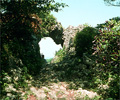 Tamagusuku Castle Ruins |
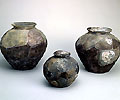 Sueki Unglazed Earthenware Vessel |
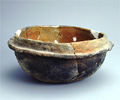 Bowl-shaped Vessel |
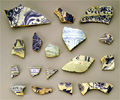 Sherds of Cobalt Blue and White China |
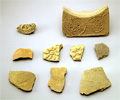 Korai Roof Tiles (Korea) |
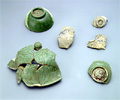 Celadon and Somesuke Porcelain Sherds |